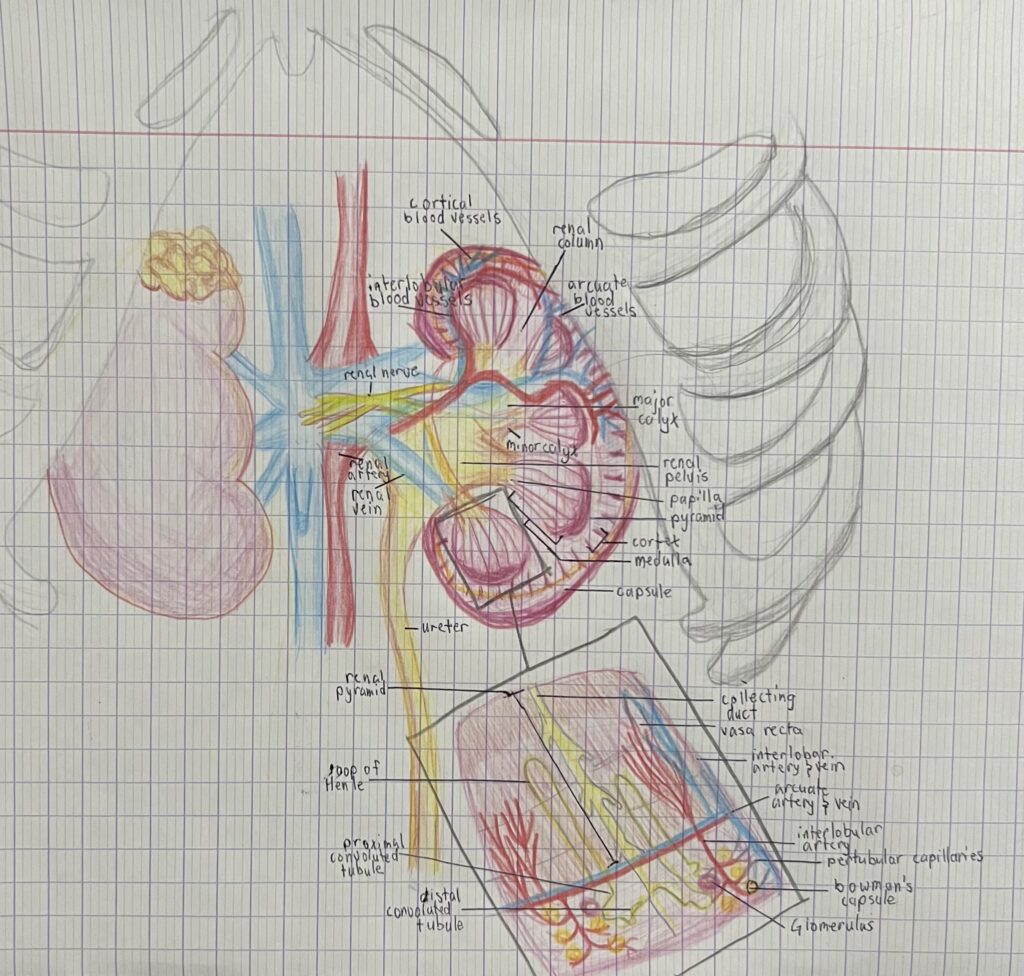
Location & Size:
Humans have two kidneys, each approximately the size of a fist, located in back of the body, at the bottom of the rib cage (National Kidney Federation, n.d.) below the diaphragm. Each kidney weighs 115-175 grams (4-6 oz) depending on gender, with males being slightly larger than females. Kidneys are approximately 11–14 cm (4.3-5.5 in) long, 6 cm (2.4 in) wide, and 4 cm (1.6 in) thick. The left kidney is anterior to the thoracic (T12) and lumbar (L3) vertebrae. The right is slightly lower due to the liver. Upper portions of both kidneys are protected in front by the eleventh and twelfth ribs (Betts et al., 2022).
Three layers of fatty connective tissue known as the renal capsule cover the kidneys. The outer layer of the kidney, the renal cortex, is where nephrons begin, and erythropoietin is synthesized. The inner part of the kidney, the renal medulla, contains most of the nephrons, as well as he glomeruli and renal tubules. Renal papilla are pyramid-shaped lobes inside the kidney responsible for transferring urine to the renal pelvis, a funnel-shaped area that collects urine then transfers it to the bladder via ureters. Filtered blood exits through the renal vein, the main blood vessel (Cleveland Clinic, n.d.).
Function:
Kidneys operate as part of the urinary system . They remove waste through metabolism. Metabolism is divided into two distinct categories: anabolism, the building and storing of energy, and catabolism, the breaking down and releasing of energy. Kidneys also balance fluid levels by removing excess fluid, and filter blood (National Kidney Federation, n.d.).
Kidneys produce erythropoietin, a hormone that travels through the bloodstream to the bone marrow, prompting the synthesis of erythrocytes (red blood cells). They also produce vitamin D, while maintaining proper ratios of calcium and phosphate in blood and bones (National Kidney Federation, n.d.).
Pathways:
First, blood passes through the renal artery into the kidney. During the first stage of filtering, blood passes through tiny blood vessels known as Glomeruli, and millions of microscopic filters called nephrons. Filtered matter is sent to renal tubules (National Kidney Federation, n.d). Water, nutrients, minerals, and electrolytes needed by the body are reabsorbed in renal tubules. Nitrogen waste (urea), muscle waste (creatinine), and acids are removed through diffusion, sent through the remaining collecting chambers, then converted to urine for removal (Cleveland Clinic, n.d.). Next, blood leaves the kidney through the renal vein, while urine leaves via the ureter.
Facts:
Kidneys reuse 225 liters (59.4 gallons) of the 227 liters (60 gallons) of fluid that is filtered daily (Cleveland Clinic, n.d.). That means 156 milliliters (5.3 oz) are filtered every minute!
The renal artery, renal vein, and ureter comprise an area of the kidney called the hilum (Wakim & Grewal, 2021)
Kidneys balance electrolytes, essential minerals including potassium and sodium (Cleveland Clinic, n.d.).
Kidneys control blood’s pH balance (Cleveland Clinic, n.d.)
Renin, a protein that increases blood pressure, and glucose (blood sugar) are synthesized in the kidneys (Cleveland Clinic, n.d.).
The hormones calcitriol (vitamin D) and erythropoietin (signal for red blood cell creation), are produced in the kidney. Cortisol, a hormone used for metabolism, reducing inflammation, regulating blood pressure, plus increasing blood sugar, is made by an adrenal gland that rests on top of each kidney (Cleveland Clinic, n.d.).
Bibliography:
Betts, J. G., Young, K. A., Wise, J. A., Johnson, E., Poe, B., Kruse, D. H., Korol, O., Johnson, J. E., Womble, M., & DeSaix, P. 2022. Ch. 1 introduction – anatomy and physiology. OpenStax. https://openstax.org/books/anatomy-and-physiology/pages/1-introduction
Cleveland Clinic. (n.d.). Kidney. Cleveland Clinic. https://my.clevelandclinic.org/health/body/21824-kidney
National Kidney Federation. (n.d.). About the kidneys. National Kidney Federation. https://www.kidney.org.uk/kidneys-the-basics
San Diego Mesa College. (n.d.). Renal Pyramid. San Diego Mesa College. Retrieved April 15, 2024, from
http://classroom.sdmesa.edu/anatomy/images/Urinary_label/renal_pyramid.jpg.
Wakim, S., & Grewal, M. (2021, September 4). 19.3: Kidneys. Biology LibreTexts. https://bio.libretexts.org/Bookshelves/Human_Biology/Hum_Biology_(Wakim_and_Grewal)/19%3A_Urinary_System/19.3%3A_Kidneys

